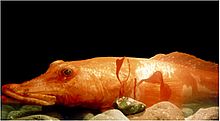| Parachaenichthys | |
|---|---|

| |
| Parachaenichthys charcoti | |
| Scientific classification | |
| Domain: | Eukaryota |
| Kingdom: | Animalia |
| Phylum: | Chordata |
| Class: | Actinopterygii |
| Order: | Perciformes |
| Family: | Bathydraconidae |
| Genus: | Parachaenichthys Boulenger, 1902 |
| Type species | |
| Chaenichthys georgianus Fischer, 1885 | |
Parachaenichthys is a genus of marine ray-finned fish belonging to the family Bathydraconidae, the Antarctic dragonfishes. They are found in the Southern Ocean around Antarctica.
Taxonomy
Parachaenichthys was first described as a genus in 1902 by the Belgian-born British ichthyologist George Albert Boulenger with Chaenichthys georgianus designated as the type species by monotypy, i.e. it was the only species in the new genus at the time of genus description. Chaenichthys georgianus had been described in 1885 by the German zoologist J.G. Fischer with the type locality given as South Georgia. The genus name Parachaenichthys is a compound of para meaning "near" or "similar to" and Chaenichthys, i.e. Channichthys the genus P. georgianus was originally placed in by Fischer.
Species
There are currently two recognised species in this genus:
- Parachaenichthys charcoti (Vaillant, 1906)
- Parachaenichthys georgianus (J. G. Fischer, 1885)
Characteristics
Parachaenichthys dragonfishes have a naked body, lacking in scales, except for lateral line scales. They have a long, broad snout and the jaws have multiple bands of small, canine-like teeth. The operculum has a clear ridge which splits up into subridges towards the rear margin, each of these subridges ends in a spine. P. charcoti attains a maximum standard length of 42 cm (17 in) while P. georgianus reaches 59 cm (23 in).
Distribution, habitat and biology
Parachaenichthys dragonfishes are found in the Southern Ocean with P. georgianus restricted to South Georgia and the South Sandwich Islands while P. charcoti is found at the South Orkney Islands, South Shetland Islands and Elephant Island, as well as at the tip of the Antarctic Peninsula south as far as 65°S. They are demersal fishes found at depths ranging from 2 to 400 m (6 ft 7 in to 1,312 ft 4 in). These fishes feed on other fishes and crustaceans.
References
- Eschmeyer, William N.; Fricke, Ron & van der Laan, Richard (eds.). "Genera in the family Bathydraconidae". Catalog of Fishes. California Academy of Sciences. Retrieved 10 October 2021.
- Eschmeyer, William N.; Fricke, Ron & van der Laan, Richard (eds.). "Species in the genus Parachaenichthys". Catalog of Fishes. California Academy of Sciences. Retrieved 10 October 2021.
- Christopher Scharpf & Kenneth J. Lazara, eds. (12 April 2021). "Order Perciformes: Suborder Notothenoididei: Families Bovichtidae, Pseaudaphritidae, Elegopinidae, Nototheniidae, Harpagiferidae, Artedidraconidae, Bathydraconidae, Channichthyidae and Percophidae". The ETYFish Project Fish Name Etymology Database. Christopher Scharpf and Kenneth J. Lazara. Retrieved 10 October 2021.
- ^ Froese, Rainer; Pauly, Daniel (eds.). "Species in genus Parachaenichthys". FishBase. June 2021 version.
- ^ O. Gon (1990). "Bathydraconidae Dragonfishes". In O. Gon and P.C. Heemstra (eds.). Fishes of the Southern Ocean. South African Institute for Aquatic Biodiversity. ISBN 9780868102115.
- Froese, Rainer; Pauly, Daniel (eds.). "Parachaenichthys georgianus". FishBase. June 2021 version.
- ^ Froese, Rainer; Pauly, Daniel (eds.). "Parachaenichthys charcoti". FishBase. June 2021 version.
| Taxon identifiers | |
|---|---|
| Parachaenichthys | |